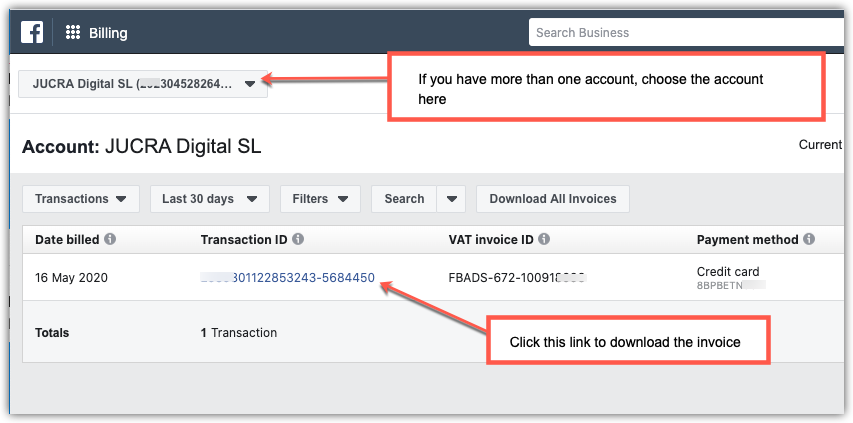Businesses are increasingly using Facebook ads to reach their target audience and promote their products or services. While Facebook provides an intuitive Ads Manager platform to manage your ad campaigns, it's essential to monitor your expenses and measure the effectiveness of your ads. One way to do this is by accessing and analyzing your Facebook Ads Receipt. Below, we will explore the importance of Facebook Ads Receipt and guide you through the process of viewing it. Furthermore, we will delve into deciphering the information on your receipt and analyzing your return on investment (ROI) from Facebook ads, along with some tips to improve your ROI.

What is a Facebook Ads Receipt?
A Facebook Ads Receipt is a detailed document that provides a record of your advertising expenses on the platform. It includes information on the campaigns you have run, the amount spent, and the specific advertisements associated with each transaction.
Why is it Important to Regularly Check Your Facebook Ads Receipt?
- Regularly checking your Facebook Ads Receipt is crucial for several reasons. It allows you to keep track of your ad expenses and ensure that they align with your allocated budget. By monitoring your spending, you can identify any discrepancies or unauthorized charges promptly.
- Enables you to evaluate the performance of your campaigns. It provides insights into the reach, engagement, and conversion metrics of your ads, helping you identify which ads are most effective and which ones may need improvement.
- Gain a deeper understanding of your target audience. The receipt provides data on the demographics and interests of the users who engaged with your ads. This information can help you refine your targeting strategy and create more relevant and compelling advertisements.
- It serves as a valuable reference for future campaigns. By studying the receipt, you can identify patterns and trends in your advertising efforts. This analysis can guide your decision-making process and help you optimize your future campaigns for better results.
- It has the ability to detect any technical issues or glitches in your ad campaigns. Sometimes, ads may not be properly displayed or tracked, leading to inaccurate reporting. By closely examining your receipt, you can identify any discrepancies between the actual performance of your ads and the reported metrics.
- Can be used as a documentation tool for financial and accounting purposes. It provides a clear and comprehensive record of your advertising expenses, which can be useful for tax reporting or budgeting purposes. Having a detailed and organized receipt can simplify the process of reconciling your advertising expenses with your financial records.
- It demonstrates a commitment to financial responsibility and accountability. It shows that you are actively monitoring and managing your advertising strategy, which can help build trust with stakeholders, such as clients or business partners.
Step-by-Step Guide to Accessing Your Facebook Ads Receipt
Navigating the Facebook Ads Manager
To access your Facebook Ads Receipt, you'll need to visit the Ads Manager platform. Start by logging into your Facebook account and navigating to the Business Manager. From there, click on the "Ads Manager" tab in the top navigation menu.
Once you're in the Ads Manager, you'll find yourself in a powerful tool that allows you to manage and monitor your Facebook advertising campaigns. With its user-friendly interface, you can easily track the performance of your ads, make necessary adjustments, and analyze the results to optimize your marketing strategies.
Locating Your Facebook Ads Receipt
Now that you're in the Ads Manager, it's time to locate your Facebook Ads Receipt. In order to access this important document, you'll want to navigate to the "Billing" tab located in the left-hand sidebar. This tab is your gateway to all things related to payments and transactions.
Within the "Billing" tab, you'll find various options and settings related to your Facebook advertising expenses. It's here that you can manage your payment methods, view your billing summary, and access your payment history. To find your Facebook Ads Receipt, simply click on the "Payment History" option.
Once you've clicked on the "Payment History" option, a comprehensive list of your recent transactions will be displayed. This list provides you with a detailed overview of the payments made for your Facebook ads. It includes information such as the date of the transaction, the amount paid, and the payment method used.
Within this section, you'll be able to easily locate and access your Facebook Ads Receipt. The receipt contains all the essential details of your transaction, including a breakdown of the charges, any applicable taxes, and the total amount paid.

Having access to your Facebook Ads Receipt is crucial for keeping track of your advertising expenses and maintaining accurate financial records. Whether you need it for personal reference, tax purposes, or to reconcile your accounts, this document serves as a reliable source of information.
Now that you know how to navigate the Facebook Ads Manager and locate your Facebook Ads Receipt, you can confidently manage your advertising budget and stay on top of your financial obligations. Remember to regularly review your payment history and keep your receipts organized for easy access and reference.
Deciphering the Information on Your Facebook Ads Receipt
The Billing Summary
The Billing Summary section of your Facebook Ads Receipt provides an overview of your ad expenses for a given time period. It includes the total amount spent, any credits or refunds applied, and the net amount payable.
When you receive your Facebook Ads Receipt, it's important to understand the information presented in the Billing Summary section. This section gives you a clear snapshot of your ad expenses, allowing you to track and manage your advertising budget effectively.
Within the Billing Summary, you will find the total amount spent on your ads during the specified time period. This figure represents the sum of all the individual transactions made for your ads. It includes the costs of running your campaigns, reaching your target audience, and achieving your advertising goals. This is crucial if you want to effectively reach conversion increase, brand building, traffic driving or any other marketing goal.
In addition to the total amount spent, the Billing Summary also highlights any credits or refunds applied to your account. These credits can be the result of Facebook's promotional offers, compensation for any issues or errors, or adjustments made due to changes in your ad campaigns. Refunds, on the other hand, are typically issued when there are billing errors or discrepancies.
Once you have accounted for the credits or refunds, the Billing Summary provides you with the net amount payable. This is the final amount that you are responsible for paying to Facebook for your ad expenses. It is important to review this figure carefully to ensure accuracy and to plan your budget accordingly.
Interpreting the Transaction History
Below the Billing Summary, you will find a detailed Transaction History. This section lists each individual transaction, including the date, amount, and description of the specific ad it pertains to. It also shows any adjustments made, such as credits or refunds.
The Transaction History is a valuable resource for understanding the breakdown of your ad expenses. It allows you to track each transaction made for your ads, providing transparency and accountability.
Each entry in the Transaction History includes the date of the transaction, allowing you to see when the specific ad expense occurred. This information can be useful for analyzing the performance of your ads and identifying any patterns or trends.
In addition to the date, the Transaction History provides the amount spent on each individual transaction. This allows you to see the varying costs associated with different ads or campaigns. By reviewing this information, you can assess the effectiveness of your advertising strategies and make informed decisions for future campaigns.
Furthermore, the Transaction History includes a description of each transaction, specifying the ad it pertains to. This description can provide valuable insights into the nature of the ad, such as its targeting parameters, creative elements, or campaign objectives. Understanding the specific ads associated with each transaction can help you evaluate their performance and make adjustments to optimize your advertising efforts.
Finally, the Transaction History also highlights any adjustments made to the transactions, such as credits or refunds. These adjustments can occur due to various reasons, such as billing discrepancies, changes in campaign settings, or Facebook's promotional offers. By reviewing these adjustments, you can ensure that your ad expenses are accurately reflected and resolve any discrepancies that may arise.
Analyzing Your Return on Investment (ROI) from Facebook Ads
What is ROI in the Context of Facebook Ads?
Return on Investment (ROI) measures the profitability of your ad campaigns. It is a metric that indicates how much revenue you generated relative to the amount spent on advertising.

How to Calculate Your ROI
To calculate your ROI from Facebook ads, you need to compare the revenue generated from your campaigns to the total cost of running those ads. The formula is as follows:
ROI = (Revenue - Cost of Ads) / Cost of Ads * 100
Tips to Improve Your ROI from Facebook Ads
Optimizing Your Ad Spend
One effective way to improve your ROI is by optimizing your ad spend. This involves continuously monitoring the performance of your ads and making data-driven decisions to allocate your budget effectively. Identify underperforming ads and reallocate your budget to those that yield better results.
Targeting the Right Audience
Another crucial aspect of maximizing your ROI is targeting the right audience. Facebook offers advanced targeting options that allow you to narrow down your audience based on demographics, interests, and behavior. By reaching the people who are most likely to be interested in your products or services, you increase the chances of generating meaningful conversions.
With this comprehensive guide, you now have a solid understanding of how to view your Facebook Ads Receipt and analyze your ROI. Remember to regularly check your receipt, decipher the information it provides, and calculate your ROI to assess the effectiveness of your advertising efforts. By implementing the tips presented here, you can optimize your ad spend and target the right audience, ultimately improving the return on your Facebook ads investment.
Final Word
Monitoring your expenses and analyzing the impact of your Facebook ads are essential for any business aiming to make the most of their advertising budget. By accessing your Facebook Ads Receipt, deciphering its information, and calculating your ROI, you can gain valuable insights into the performance of your ad campaigns. Utilize the tips provided to improve your ROI and achieve better results from your Facebook ads or any other type of Social Media Advertising. Harness the power of data and strategy to optimize your ad spend, target the right audience, and grow your business through Facebook advertising.


-AK-148968-preview.png?width=842&height=310&name=1.01-1x1px-Embertribe-(Client-Services)-AK-148968-preview.png)








-1.jpg)






%20-%20500x500%20-%20SP%20-%2045.01.png)
%20-%20500x500%20-%20SP%20-%2049.01.png)
%20-%20500x500%20-%20SP%20-%2057.01.png)


.png)